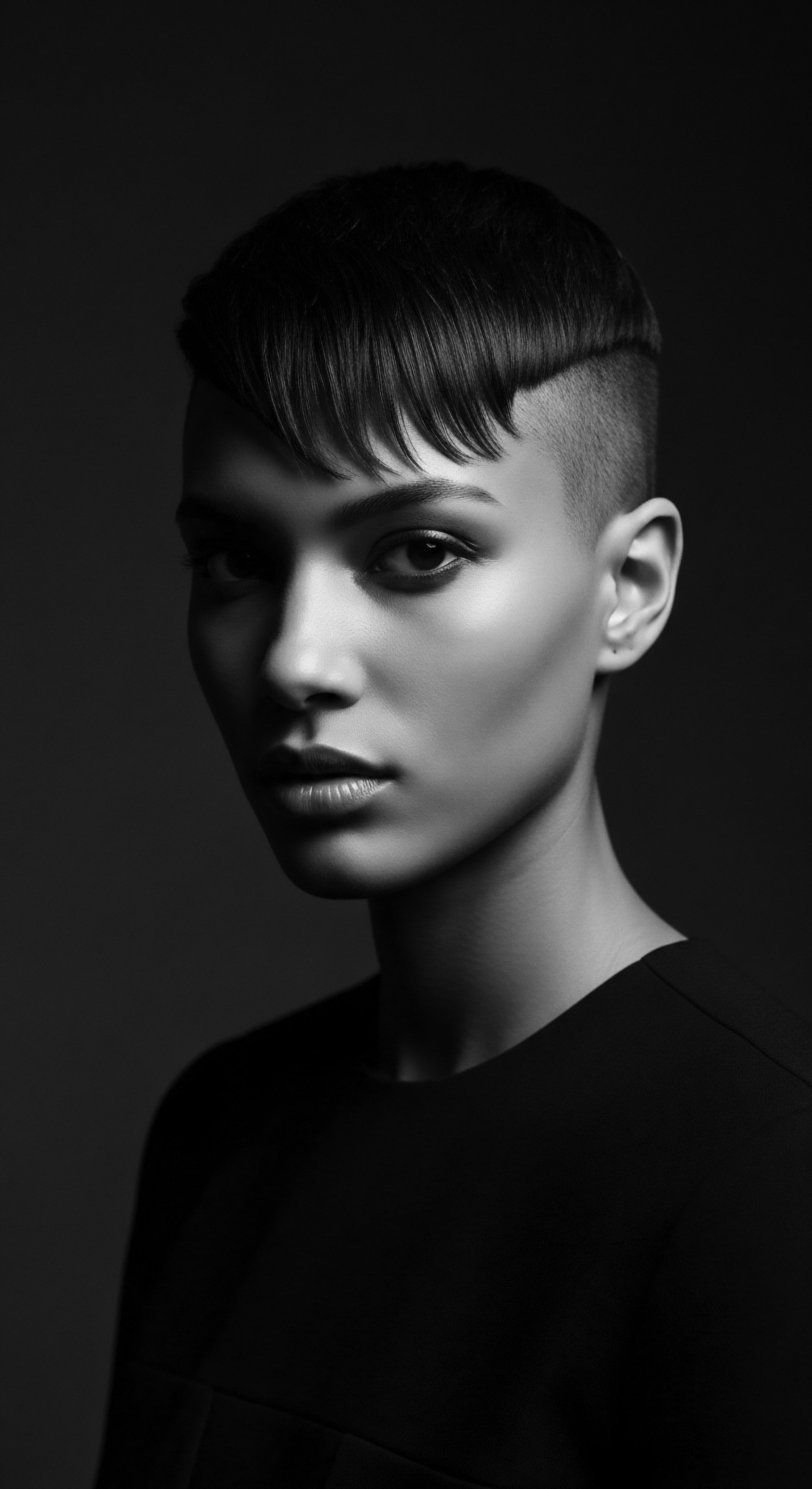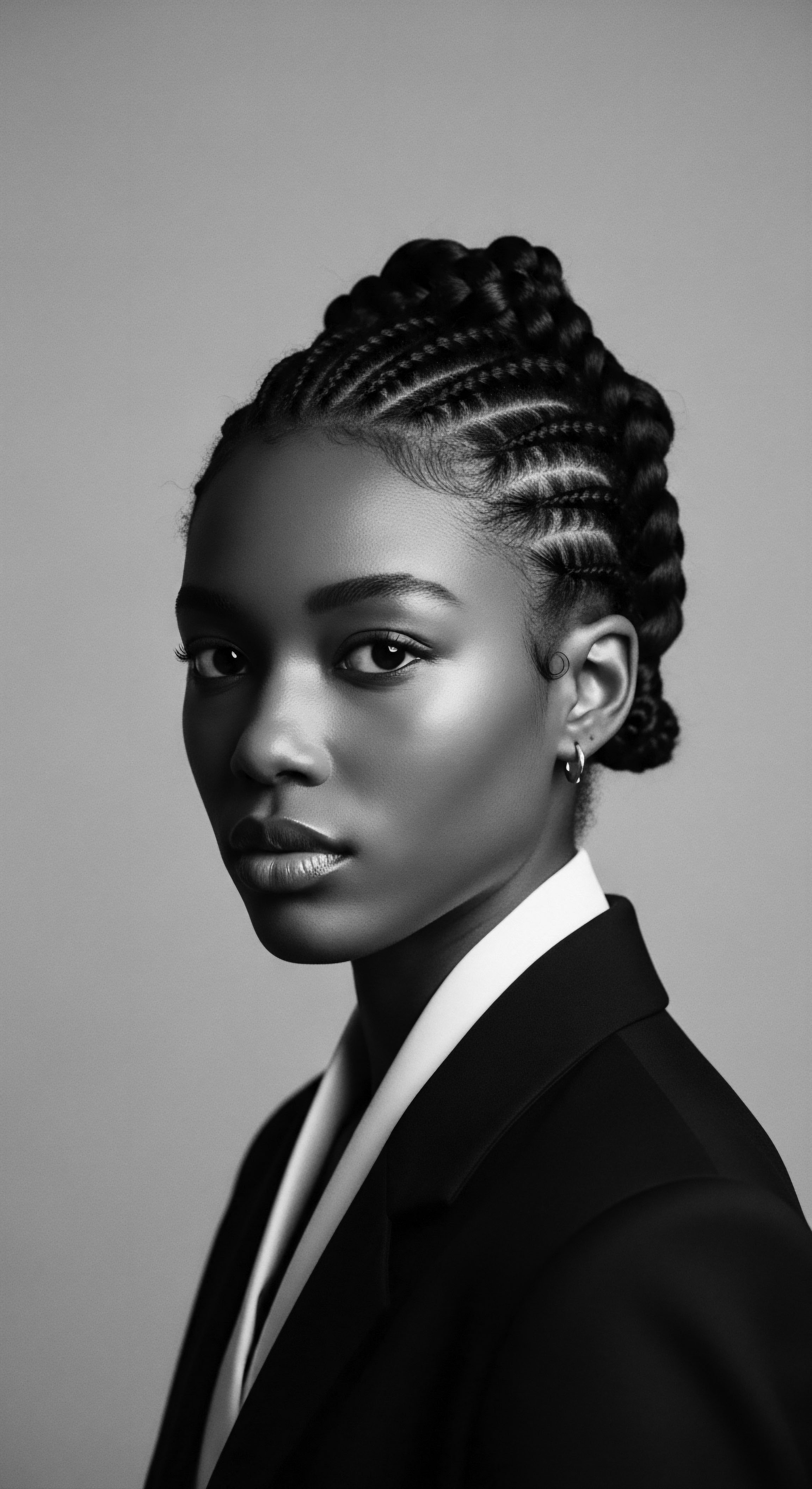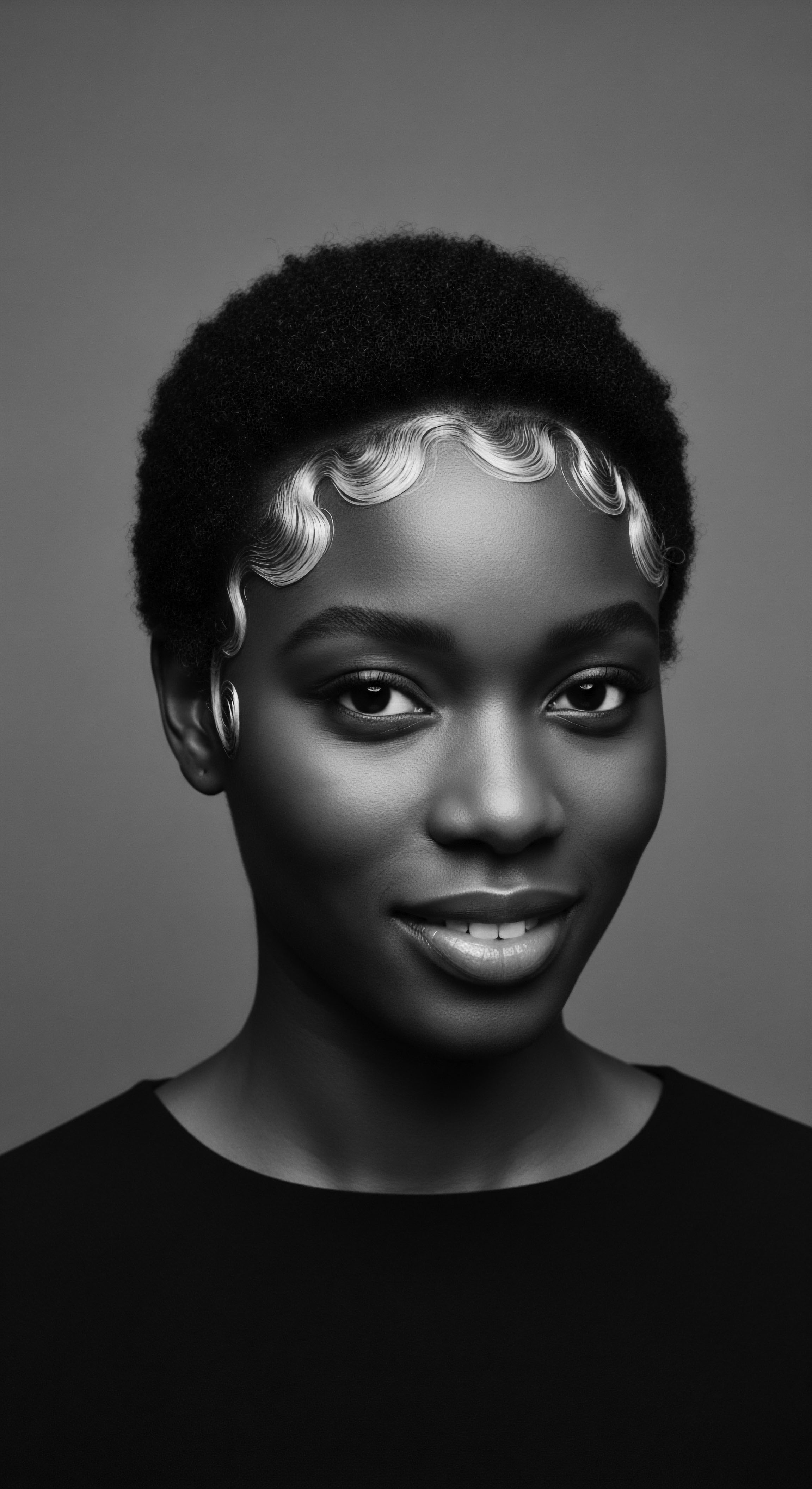
Roots
For generations, the strands upon our heads have not merely been adornment; they are living narratives, etched with the stories of our forebears, whispers of ingenuity born from profound knowing. Each coil, every wave, is a testament to an ancestral legacy, a deep connection to the earth and the sun, carried within the very architecture of our being. To truly see textured hair is to gaze upon a marvel, a biological symphony playing out across countless heads, each note distinct, yet bound by a shared, resilient spirit.
Understanding what structures shape this wonder allows us to listen more intently to the ancient wisdom held within each fiber, a wisdom that guided care long before microscopes revealed the secrets. We consider these internal workings not as isolated facts, but as vital keys to unlocking the voluminous archive of textured hair heritage.

The Follicle’s Ancestral Embrace
At the root of every hair strand, nestled beneath the skin, lies the hair follicle – a singular, almost sacred chamber that dictates the hair’s very inclination. For textured hair, this follicle often presents not as a perfect circle, but as an elliptical or kidney-shaped aperture. This unique form shapes the emerging hair shaft, encouraging it to curve, coil, or wave as it grows. The orientation of the follicle beneath the scalp, rather than emerging straight, influences the spiraling journey of the hair as it leaves its epidermal home.
Think of it as the earth’s axis guiding the spiral of a growing vine; the follicle’s tilt determines the initial direction and eventual pattern of the strand. This subtle, internal geometry is a primary determinant of curl pattern, a blueprint inherited through countless generations.
The inclination of the follicle means that a straight pathway from scalp to tip is rarely the case for textured hair. Instead, the hair fiber spirals and bends, a journey that inherently places tension at various points along its length. This biological characteristic historically informed how communities approached hair care.
Traditional combs, often wide-toothed or finger-like in their design, were not accidental; they were crafted to navigate these natural curves, respecting the hair’s organic pathway from the follicle. The very acts of detangling and styling became ceremonies of alignment, working with the hair’s biological inclination rather than against it.
The elliptical shape of the hair follicle lays the fundamental groundwork for textured hair’s distinct curl patterns, a biological inheritance passed down through time.

The Hair Shaft’s Internal Wisdom
Moving beyond the follicle, the hair shaft itself, the visible part of the hair, holds further biological insights. It comprises three primary layers ❉ the cuticle, the cortex, and in some cases, the medulla. In textured hair, these layers exhibit characteristics that contribute to its unique qualities and care requirements. The Cortex, the hair’s primary structural component, is where keratin proteins are arranged.
In textured hair, this arrangement can be less uniform, contributing to points of fragility along the hair shaft’s twists and turns. The Cuticle, the outermost protective layer, consists of overlapping scales. For textured hair, these cuticle scales tend to be more lifted or open, which, while beautiful, can allow moisture to escape more readily and make the hair more prone to tangling.
Consider the significance of the Medulla. This innermost layer, often a discontinuous or absent core in textured hair, provides less structural support compared to straight hair, which typically has a continuous medulla. This absence or discontinuity affects the hair’s tensile strength and elasticity. This biological reality, though not scientifically understood in ancient times, was likely sensed through generations of handling and observing hair.
Communities learned that textured hair benefited from gentle manipulation and consistent moisture, practices that intuitively countered the physical vulnerabilities conferred by its internal structure. These practices were not just about aesthetics; they were about preserving the integrity of the hair, a profound connection to ancestral knowledge.
The inherent architecture of textured hair, with its unique follicular shape and internal shaft characteristics, shapes its interaction with the environment and its need for specific care. This understanding is foundational to appreciating the deeply rooted care traditions that have kept textured hair vibrant for millennia.

Ritual
The intricate dance between hair’s inherent biology and the hands that tend it has shaped countless rituals, passed down through generations. These acts of styling and maintenance, often perceived simply as beauty routines, were and remain profound expressions of heritage, resilience, and community. The very structures that lend textured hair its magnificence also dictate the techniques and tools required to honor its unique form, linking scientific understanding to ancient practices.

How Does Hair Structure Shape Styling?
The coil of textured hair, born from the elliptical follicle, means a single strand rarely hangs straight. This natural inclination lends itself to myriad styling possibilities, from protective braids that harness the hair’s tendency to intertwine, to wash-and-go styles that celebrate its inherent spring. The relatively lifted cuticle layer, while making textured hair prone to moisture loss, also creates opportunities for products to penetrate and define curls. Historically, this understanding drove the use of heavy, emollient oils and butters – like shea butter or palm oil – to seal the cuticle and retain hydration, practices that intuitively worked with the hair’s biological needs.
The strength of the hair, influenced by its cortical structure and the presence (or absence) of a continuous medulla, also plays a part in styling choices. Hair that is inherently more fragile due to its biological composition demands styles that minimize stress and tension. This gave rise to the enduring legacy of protective styles—cornrows, twists, and locs—which not only safeguarded the hair from environmental damage but also celebrated its inherent ability to hold shape when manipulated. These are more than mere aesthetic choices; they are a legacy of discerning how to best preserve the hair’s structural integrity over time.

Tools Forged From Understanding
The tools accompanying textured hair care have always reflected an intimate knowledge of its biological structures. Consider the earliest combs found in archaeological digs across Africa. Often crafted from wood, bone, or ivory, their wide-set teeth were designed to glide through coily strands without causing undue breakage.
Unlike the fine-toothed combs suited for straight hair, these ancestral instruments respected the natural path of each curl, acknowledging the potential for tangling due to the hair shaft’s irregular shape and lifted cuticle. Their design was a direct response to the hair’s biology, a testament to practical wisdom passed down through ancestral lines.
Traditional African tools, particularly wide-toothed combs, exemplify an ancient intuitive understanding of textured hair’s delicate biological structures.
Another profound example lies in the practices of braiding and twisting, which require no tools beyond skilled hands. These techniques leverage the hair’s natural inclination to interlock and hold shape. The friction and tension created during these processes distribute stress across multiple strands, reinforcing the hair’s overall resilience against environmental aggressors.
This communal act of styling, often performed within families and communities, served not only a practical purpose of hair preservation but also strengthened social bonds. Such acts were a living demonstration of the human element, understanding and honoring the hair’s biological design in daily life.
| Tool Type Wide-Toothed Combs |
| Traditional Origin/Use Ancient Egypt, West African cultures for detangling and styling. |
| Biological Structure Interaction Navigates irregular hair shaft twists, minimizes breakage on lifted cuticles. |
| Tool Type Hair Picks/Afro Picks |
| Traditional Origin/Use Developed to lift and shape full, voluminous textured hair post-follicle emergence. |
| Biological Structure Interaction Works with the natural spring and density of coiled strands, respecting the elliptical follicle's output. |
| Tool Type Headwraps/Bonnets |
| Traditional Origin/Use Across African and diasporic cultures for hair protection and adornment. |
| Biological Structure Interaction Shields fragile cuticles from environmental damage and friction, preserving moisture in strands prone to dehydration. |
| Tool Type These tools stand as physical testaments to generations of discerning how to care for textured hair's unique biology. |

What Role Does Hair Structure Play In Traditional Hairstyling?
The specific ways hair structures affect styling are numerous. For instance, the elasticity of the hair shaft, a property greatly influenced by the cortex’s keratin organization, dictates how well hair can be stretched and rebound without breaking. This is particularly relevant in styles like braids and twists, where hair is manipulated into specific forms. The hair’s natural elasticity allows these styles to hold their shape and resist slippage.
Conversely, a loss of elasticity, often a sign of damage to the hair’s internal protein structure, makes styling difficult and increases vulnerability to breakage. This was implicitly understood through trial and error, as communities developed braiding techniques that honored the hair’s limits.
Another aspect is the hair’s natural porosity, largely governed by the cuticle. Hair with high porosity, common in textured hair due to the lifted cuticle, absorbs moisture rapidly but also loses it quickly. Traditional styling often involved layering products—a lighter leave-in or water, followed by a heavier oil or butter—to effectively seal the cuticle and trap moisture. This layering approach was a direct, practical response to the hair’s biological tendency to dehydrate, a testament to generations of observation and collective knowledge.

Relay
The journey of textured hair care, from ancient practices to modern scientific insights, forms a continuous relay, each generation passing on a deeper understanding. The biological structures of the hair—its unique follicle, its internal shaft characteristics, its outer cuticle—remain constant, yet our comprehension of their intricacies continues to unfold. This evolving knowledge informs holistic care, nighttime rituals, and problem-solving, all while retaining a deep reverence for the wisdom passed down through our ancestry.

What Historical Practices Inform Modern Textured Hair Care?
Many of today’s best practices for textured hair have echoes in historical traditions, rooted in an intuitive grasp of hair biology. The emphasis on moisture, for example, is not new. Across the African diaspora, various plant-based oils and butters have been used for centuries. In many West African communities, shea butter, derived from the nuts of the shea tree, was (and still is) a staple.
Its rich emollient properties helped to coat the hair shaft, sealing the relatively lifted cuticles of textured hair and preventing moisture loss. This practice directly addresses the hair’s biological predisposition to dryness. Similarly, the use of protective styles, a common practice in many African societies, served to minimize manipulation and exposure to harsh environmental elements, thereby preserving the delicate hair structures from breakage and environmental stress.
The wisdom of these ancestral practices often reflects a keen observation of natural phenomena and their effects on hair. The recognition that hair, especially textured hair, thrives when protected and nourished led to a cultural emphasis on these rituals. This is not just anecdotal; the efficacy of such practices has been increasingly affirmed by modern scientific understanding of hair biology. The longevity of these methods speaks to their inherent effectiveness, a testament to the cumulative knowledge of generations.
A specific historical example illustrating this biological awareness is found in ancient Egyptian hair care. While not exclusively ‘textured’ in the modern sense, hair was highly valued, and extensive effort was put into its care. Evidence from tombs and historical texts indicates the use of various botanical extracts and oils for hair conditioning and styling, such as almond oil, castor oil, and specialized fats. These emollients, applied to hair and scalp, would have helped to seal the cuticle and lubricate the hair shaft, particularly for hair types that retained moisture less effectively.
This practice directly addressed the hair’s physical properties, promoting flexibility and reducing brittleness. Such meticulous care, driven by a desire for healthy and aesthetically pleasing hair, highlights an early, empirical understanding of how specific substances interact with hair’s biological structures (Lucas, 1962). The careful concoction of these blends speaks to a discerning eye for what benefits the hair, a direct lineage to our current holistic wellness approaches.

The Nighttime Sanctuary And Hair Protection
The biological vulnerability of textured hair, particularly its tendency towards dryness and tangling due to its unique structure, makes nighttime protection a vital ritual. The practice of wrapping hair or covering it before sleep, using materials like satin or silk, has deep historical roots across diverse cultures. In many Black communities, the bonnet or headwrap became a symbol of care, a protective cocoon for the hair. This tradition was not merely for aesthetic purposes; it directly mitigated friction against coarse fabrics like cotton pillowcases, which can abrade the hair’s cuticle, leading to frizz, breakage, and moisture loss.
The smooth surface of satin or silk allows the hair to glide, preserving the integrity of the delicate outer layer and reducing mechanical stress on the hair shaft’s irregular structure. This ancestral wisdom of nighttime protection directly addresses the hair’s biological needs, ensuring longevity and vitality.
- Silk Headwraps ❉ Ancient practices in various African societies used soft fabrics to protect hair from dust and environmental elements. The smooth texture of silk minimizes friction, preserving the cuticle layer of textured hair.
- Shea Butter ❉ Utilized across West African communities for centuries, this natural fat helps seal the hair’s lifted cuticles, providing moisture retention for strands prone to dryness.
- Protective Braiding ❉ Techniques like cornrows and twists, common across the diaspora, shield the delicate hair shaft from daily manipulation and environmental stress, maintaining its structural integrity.

Ancestral Ingredients And Biological Harmony
The ingredients favored in ancestral hair care often reflect a deep understanding of what textured hair’s biological structures require to thrive. Consider the mucilage-rich plants like okra or aloe vera, traditionally used as conditioners and detanglers. These natural substances provide ‘slip,’ which aids in detangling tightly coiled strands and minimizing breakage on fragile points along the hair shaft. This ‘slip’ acts as a biological lubricant, allowing tools and fingers to move through hair without excessive force, thereby protecting the cuticle and cortex from damage.
Similarly, proteins from ingredients like rice water, often used in traditional Asian hair care, provide reinforcement to the hair’s keratin structure. While these practices are culturally distinct, their underlying principle—applying strengthening or conditioning agents—shows an intuitive grasp of hair’s biological composition and how to maintain its strength.
The journey from understanding the hidden architecture of our hair to the conscious, ritualistic care we offer it is a living relay. Each generation contributes to this rich tapestry, weaving together scientific insight with the enduring wisdom of our forebears, always with a profound respect for the heritage held within each strand.

Reflection
To contemplate the biological structures influencing textured hair is to look beyond the surface, to recognize the profound lineage held within each magnificent coil and curl. It is a journey not just through cellular architecture, but through centuries of human experience, of resilience carved into the very fiber of identity. Each hair strand, from the elliptical embrace of its follicle to the intricate dance of its cortical cells, carries an echo of ancestral wisdom, a testament to how our communities have long understood and honored this unique biological heritage. This appreciation allows us to perceive hair care not as a fleeting trend, but as a living archive, a continuous conversation between ancient knowing and modern understanding, forever bound by the Soul of a Strand.

References
- Lucas, Alfred. (1962). Ancient Egyptian Materials and Industries. Edward Arnold Publishers.
- Byrd, Ayana. (2014). Hair Story ❉ Untangling the Roots of Black Hair in America. St. Martin’s Griffin.
- Branch, Dianne. (2018). The Science of Black Hair ❉ A Comprehensive Guide to Textured Hair. CreateSpace Independent Publishing Platform.
- Lewis, Kimberly. (2007). The Curlies ❉ A Guide to Natural Hair. CreateSpace Independent Publishing Platform.
- Hunter, Tera W. (1997). To ‘Joy My Freedom ❉ Southern Black Women’s Lives and Labors After the Civil War. Harvard University Press.
- Thyssen, Anne. (2016). Hair ❉ A Cultural History. University of Chicago Press.
- Tobin, Sarah. (2018). African-American Hair Care ❉ A Cultural and Historical Perspective. Kendall Hunt Publishing.
